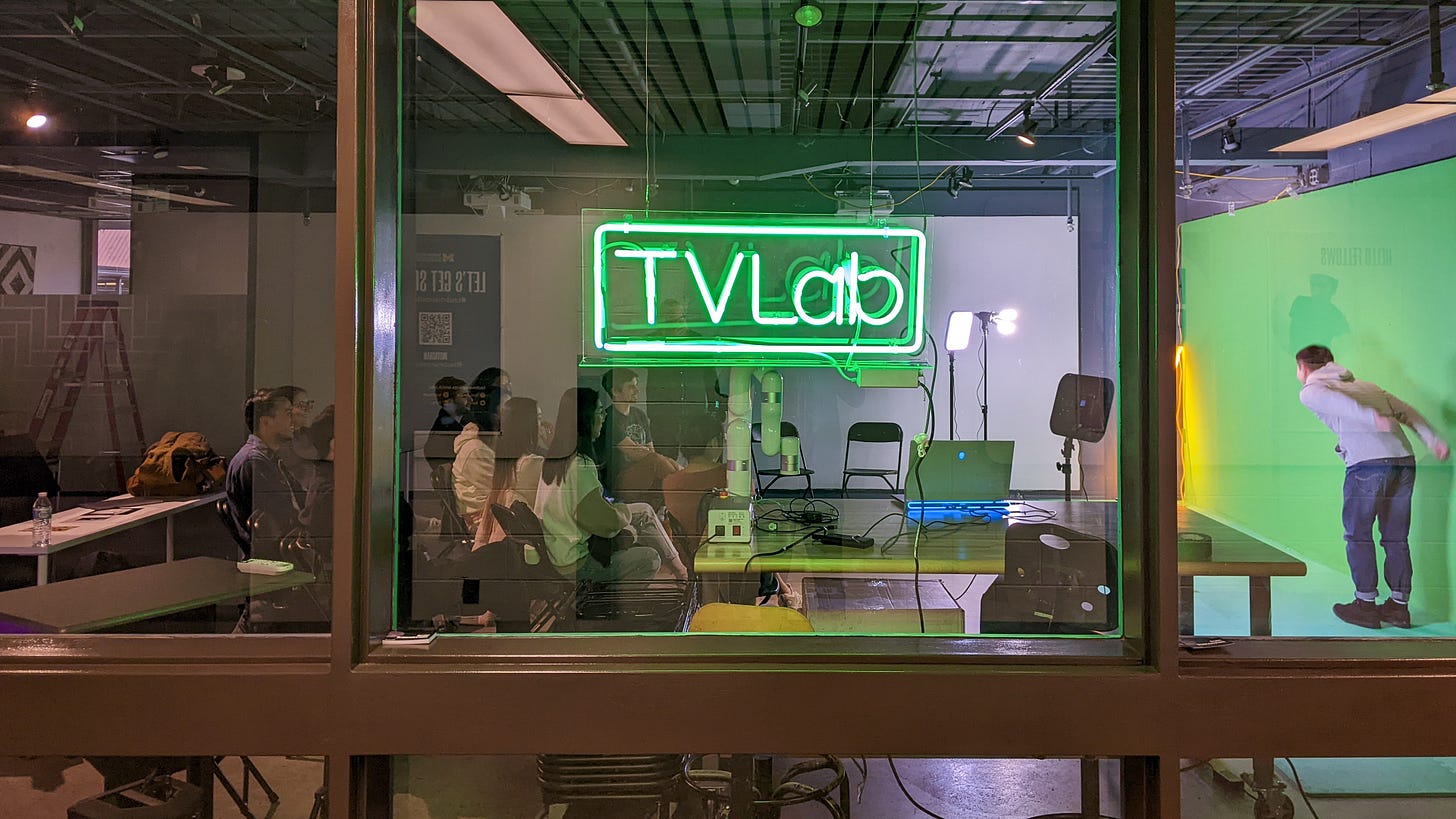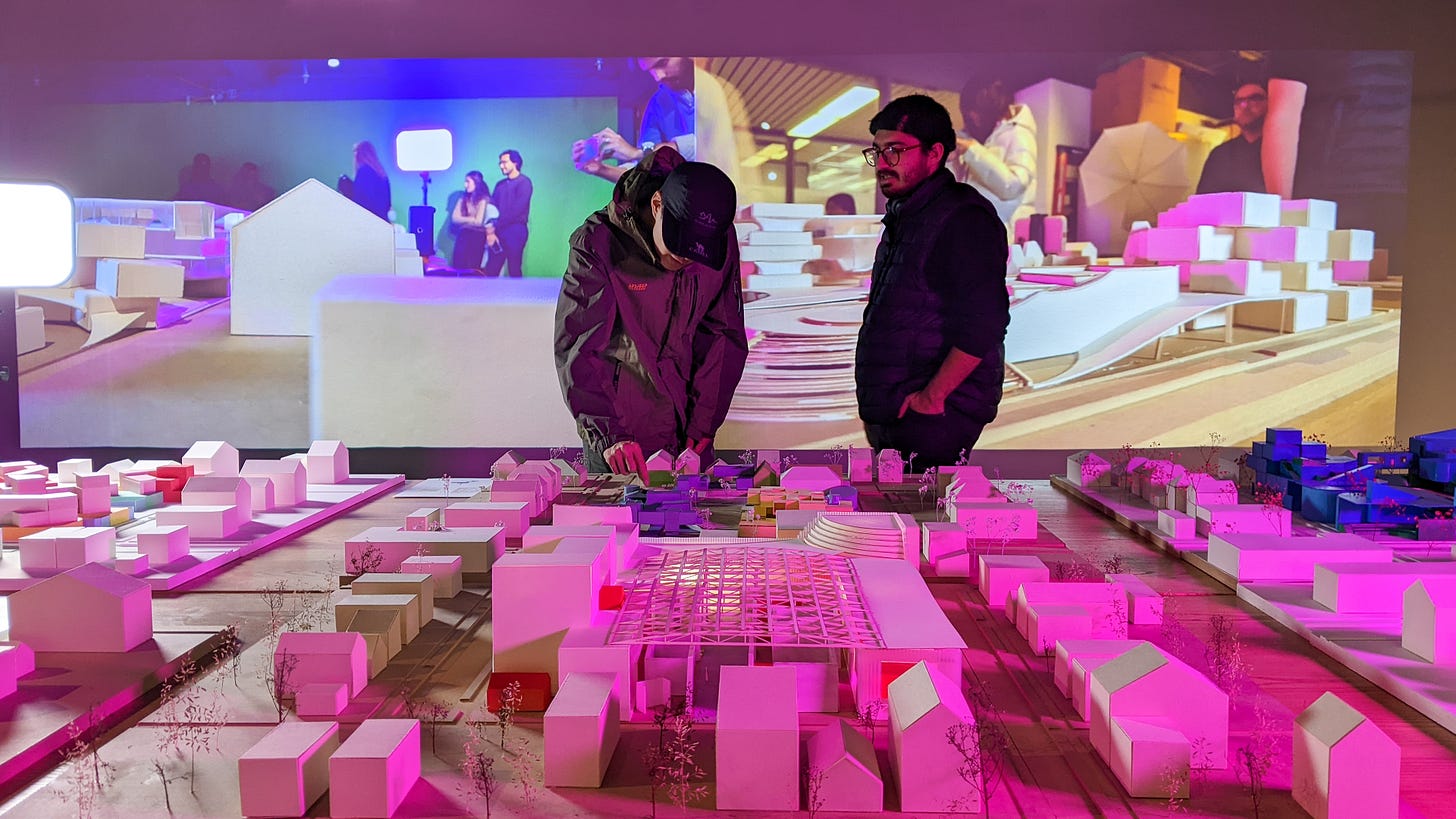Urban Technology at University of Michigan week 129
Interview with the Taubman Visualization Lab
One of the things that makes architecture and urban planning colleges different from the average liberal arts endeavor is that they have rooms full of life-threatening equipment, like table saws and 5-axis robots armed with incredibly sharp bits. (We have one of those and it’s awesome.) Making physical models and objects is a critical part of what we do. Ultimately a place like Taubman College exists to make the world in new ways, and to do that one must also see the world in new ways.
That’s where the Taubman Visualization Lab (TVLab) comes in. The newest lab space at our humble College is dedicated to technologies of vision in a capacious sense: not confined to literal “seeing,” the TVLab is a place for sensing, capturing, and manifesting the world around us. And neon lights, of course.
We caught up with the co-instigators of the TVLab for an interview.
💬 Hello! This is the newsletter of the Urban Technology program at University of Michigan, in which we explore the ways that technology can be harnessed to nurture and improve urban life. If you’re new here, try this short video of current students describing urban technology in their own words.
CALL FOR PROPOSALS - We’re offering three people $15k protogrants in support of experimental software and hardware projects that advance decarbonization, climate resilient infrastructure, just energy transitions, and/or circular economies.
We want to know how hardware and software can aid in planning, designing, building, operating, analyzing, and living within cities that are as digital as they are physical. How can carefully-applied technology help grow tendrils of this bright green future in present-day soil?
MORE DETAILS AT PROTOGRANT.IO
📺 Talking Shop with the TVLab
Jacob Comerci is a designer, lecturer in architecture, and do-er of many things at Taubman College. He works with Ishan Pal Singh, also a lecturer. Working with Associate Dean Anya Sirota, they have conceptualized, built, and now operate the TVLab. We caught up with Ishan and Jacob to peer inside the lab.
Bryan Boyer: Please give us a tour of the lab as if it were a well-formed image caption alt text.
Ishan Pal Sing: I can start with the reason we called it the TVLab. I think you know that what we do here is really an Extended Reality or XR lab, but we tended toward calling it “TVLab” because “XR” is the term of today, and I think that these stones change and new technologies come. Visualization has been part of architecture and urban design for the longest time in the form of sketches, painting, and rendering. So the name TVLab comes from calling it a visualization lab rather than limiting ourselves to just VR or AR.
It’s also a double entendre because when you are standing outside in the hallway you're actually looking at the projectors through the windows, so the windows act like the glass of an old television.
Bryan: This is a long image caption…
Jacob Comerci: Right. The first thing you'll see is a neon sign green neon sign that says “TVLab.” Next you might see three short-throw projectors that are linked flush against one another forming a video wall of about 30 feet in length. Then you'll see a large green wall next to it, and probably a large green floor. At any given time you might see people in there with studio lights making funny motions, and then an image of them, but composited into a [digital] scene projected by the video projectors. I don't know, what else is there?
Ishan: A lot of cables? But hopefully with my cable management you can't see them.
Bryan: What is the most frequent question people ask you about the TVLab?
Ishan: “How can I book it?” There's been a lot of times where I've been sitting inside and someone's come saying, “okay, so what is this? What is this space? How can I use it?”
Jacob: “What do you have? Can I have this thing that you don't have? Can we get it as soon as possible?” People are curious about the stuff and we've done our best to be accommodating and accessible to those who don't know. You may know what a VR headset is, for instance, but people are curious and want to try one out.
Bryan: What does “visualization” mean for the TVLab?
Jacob: “Visualization” is broad enough that it can encapsulate any number of technologies without being pigeonholed into the world of headsets and things like that, as Ishan mentioned earlier. There are numerous labs on campus that deal with XR directly, including across the street at the Duderstadt Center, so there's some familiarity that people would have with the “XR” as a phrase, but “TVLab” is more catchy, isn’t it?
Ishan: We help people capture, manipulate, and produce imagery. That happens with virtual production (like the magic that made The Mandalorian possible), augmented reality, virtual reality, green screen and video, laser scanning, and whatever else people get into.
Bryan: What's an example of something you would consider to be at the fringes of your definition of visualization?
Ishan: AI, and specifically Generative Adversarial Networks, is at the fringes of visualization at the TVLab. Mid Journey and Stable Diffusion are creating new possibilities for us and right now we’re experimenting in little ways. The kind of technologies that are coming into like world with AI emphasize the role of curation within the realm of visualization. It’s going to be an interesting direction for visualization in general.
Jacob: How would you answer that question, Bryan?
Bryan: For me it's maybe more like simplistic. The fringes might be about introducing different tools or media. We’re running our first studio right now and the students are working on information architecture and data visualization. I was encouraging Elisa, who is teaching the studio, to consider data viz with materials like rocks, stones, or trash that has been collected outside.
It puts the literal material and the aesthetic of that visualization into a completely different register. And working with obstinate objects is also clumsy in a way that's useful. It helps us learn how to work with the material world and slows down the visualization process such that there’s really time to obsess over basics like composition, proportion, color, or these these other factors of differentiating things in a visual field.
The intersection of visualization and materiality, I think, is one spot I would consider fringe, perhaps because I feel drawn to this at a moment when everything else seems to be dematerializing.
Bryan: Maybe 15 to 20 years ago “Fab Labs” became a meme that spread, I believe from MIT first and then throughout the world. So I'm curious, is TVLab something similar, or is this idea one that you all have invented? How unique is the TVLab?
Ishan: None quite like this. Other schools have labs that focus on XR or spaces that are shared across the whole campus, but we are unique in that we’re bringing a space for experimentation to all disciplines that think about the future of cities.
We also said, “Let's try to get all the equipment that people could possibly use and see what happens!” We want to see, for example, if most people just want VR headsets or maybe more people want green screens and virtual production stuff. So if the TVLab is a newly invented idea, it’s actually still being invented and moved forward. This is just our first semester.
Jacob: One thing we found elsewhere is that individual faculty often set up labs with some money from the university and those spaces tend to become closed—a lab for a very small number of people. The TVLab is a really cool resource that’s open to everyone at Taubman. If you come here and want to use the Lab: you will, you can!
Bryan: The TVLab is more than just a space and some gizmos though, right?
Jacob: It's definitely people too—first and foremost, Ishan. If he’s not in there the TVLab does not run smoothly [yet]. So yes, the Lab is people and know-how, a mentality to support faculty and students, and an openness to anyone who comes. Anya has been very clear about this from the start.
Ishan: If we opened the lab with some equipment and just left it like that, and told everyone to figure it out, I don't think it would be successful. A big portion of making the lab work is making visualization as broadly accessible as possible. It’s really important to get people to feel like the pressure is off their shoulders and that they can come inside the lab and play.
[Ishan gets pulled away to help a class of students in the lab, so the interview concludes with Jacob.]
Bryan: What is your favorite city and why?
Jacob: My favorite city I've been to is Madrid. I think that the scale is excellent, and the nightlife is incredible—you can be out at two in the morning and be next to a 75-year-old man sipping a small beer and eating little chips. It's not the sort of ‘smash a beer can on your forehead’ type of 2 a.m. It's very relaxed and people are just having dinner late and then hanging out for a bit.
These weeks: Design research. Great Lakes Travel Planning and booting up a tour agency. Dialing things in. Pamphlets. Buyer’s remorse. 🏃








